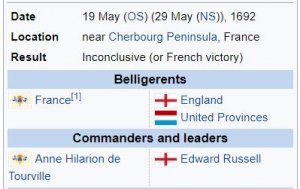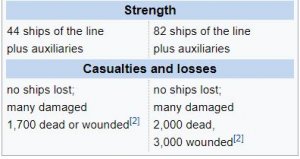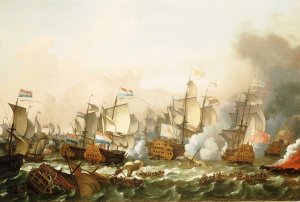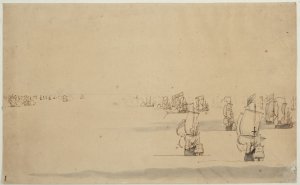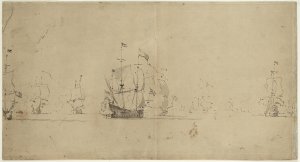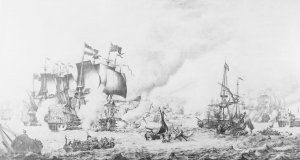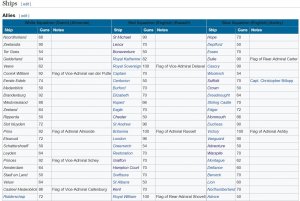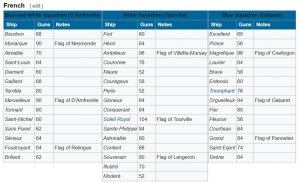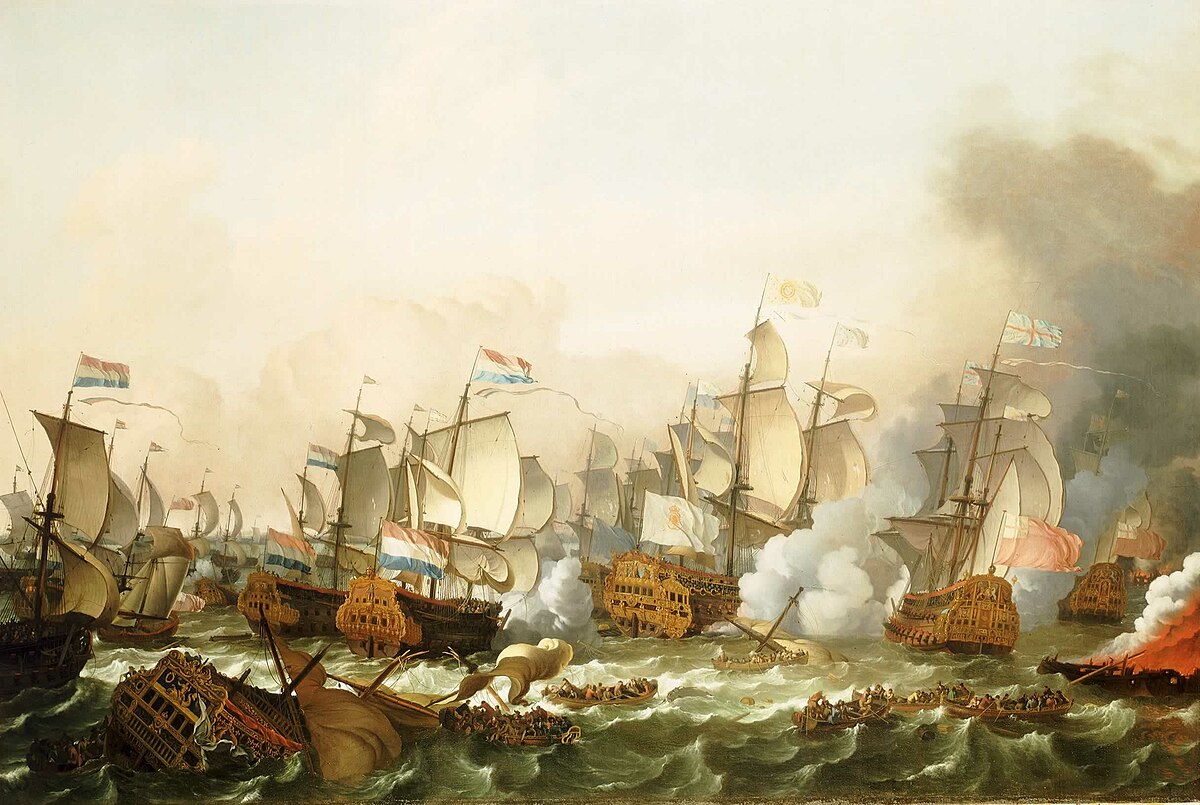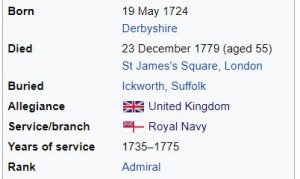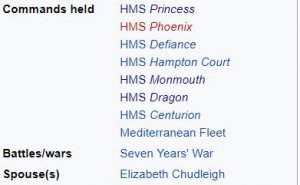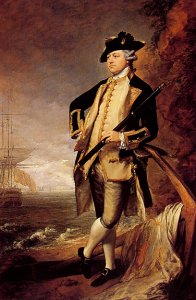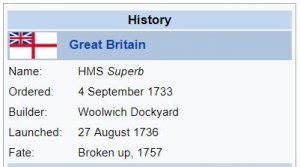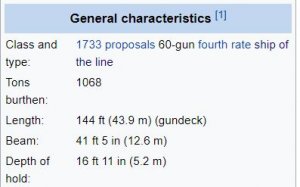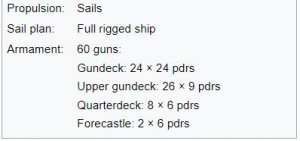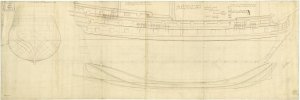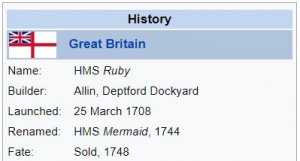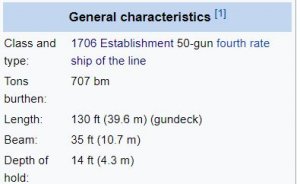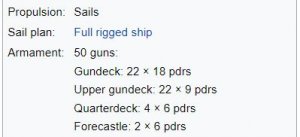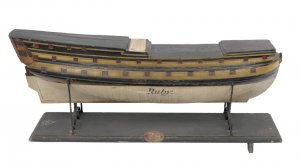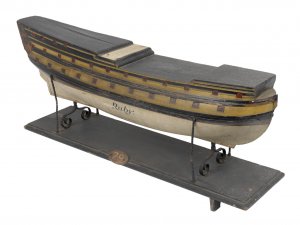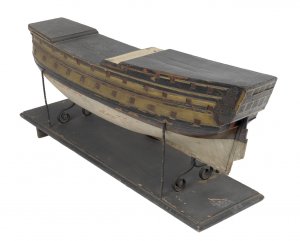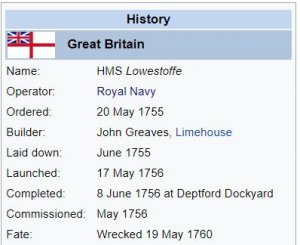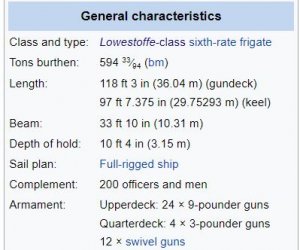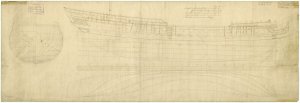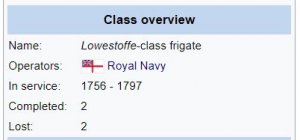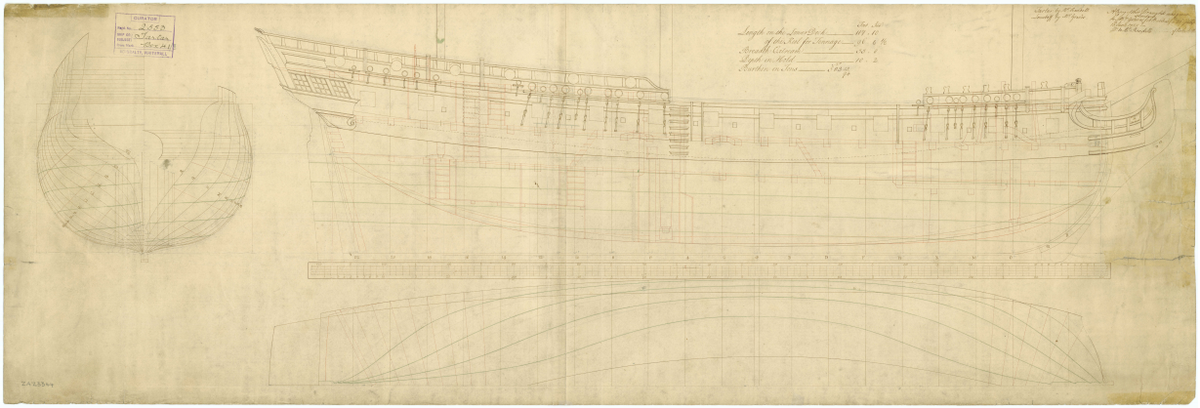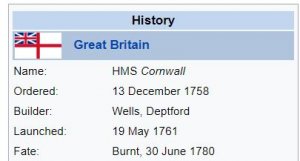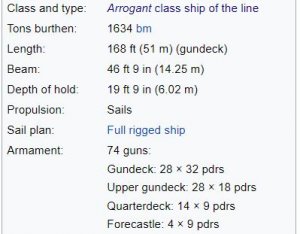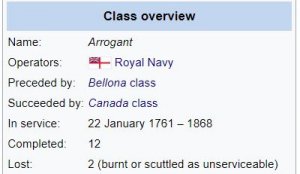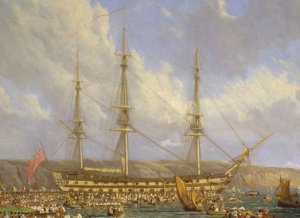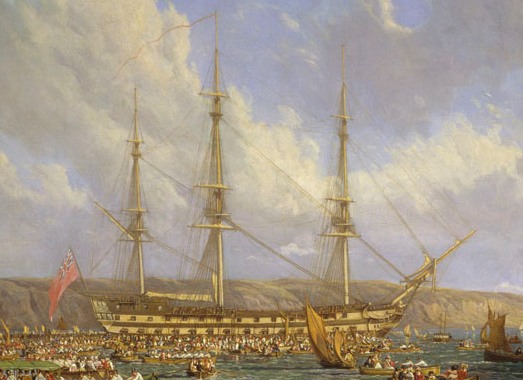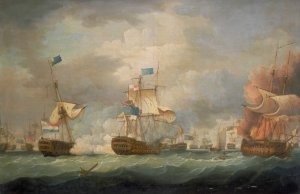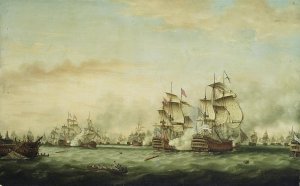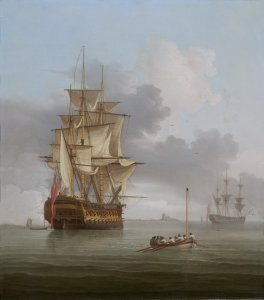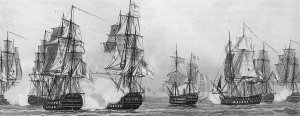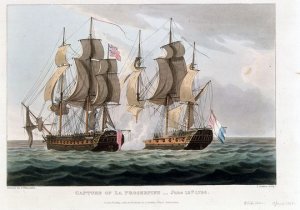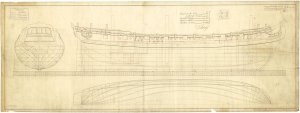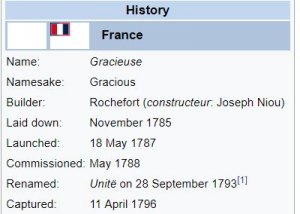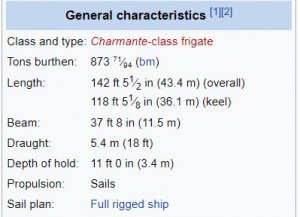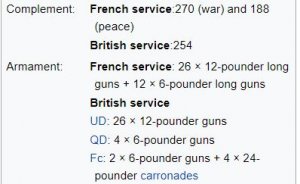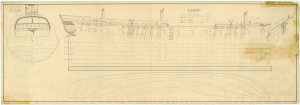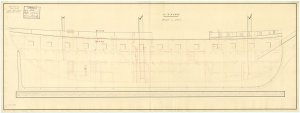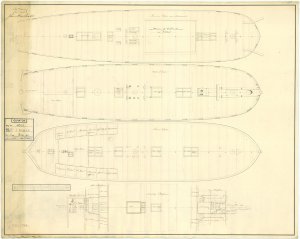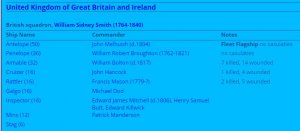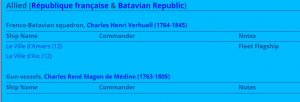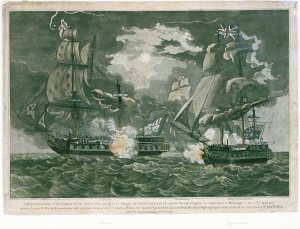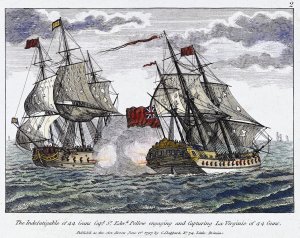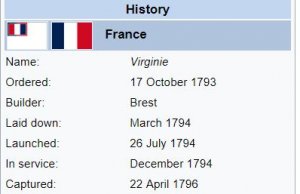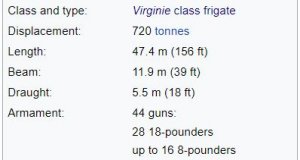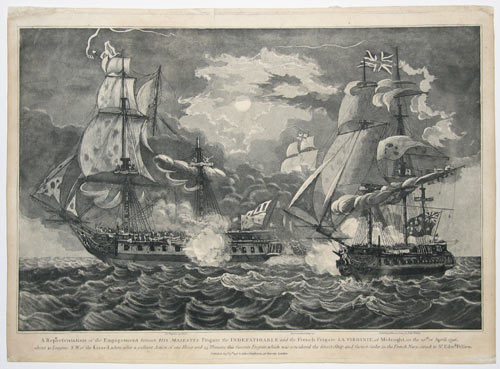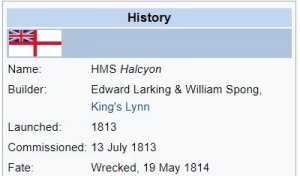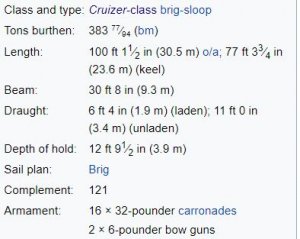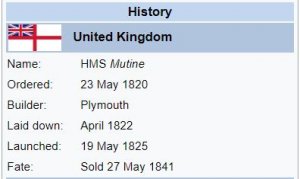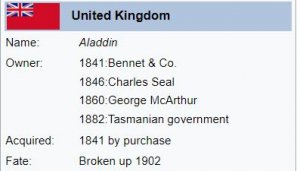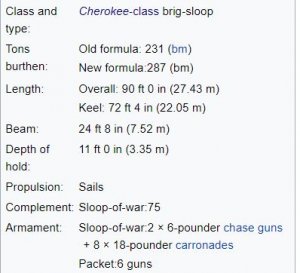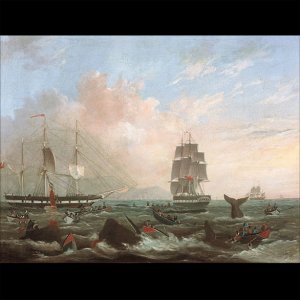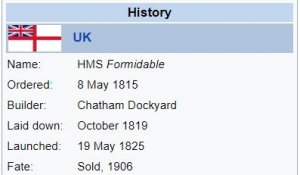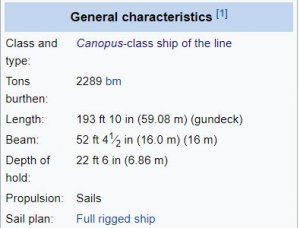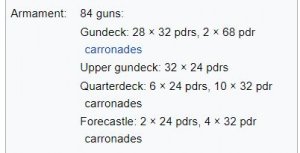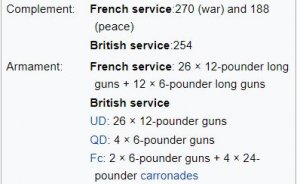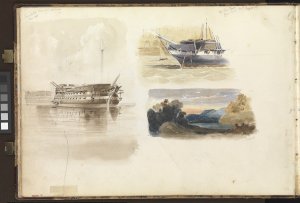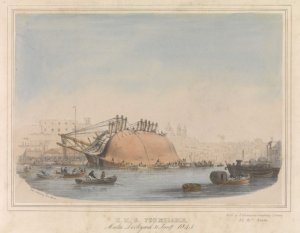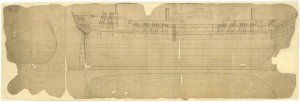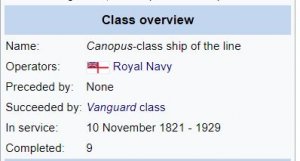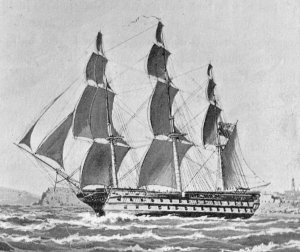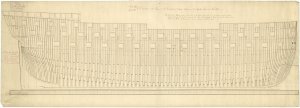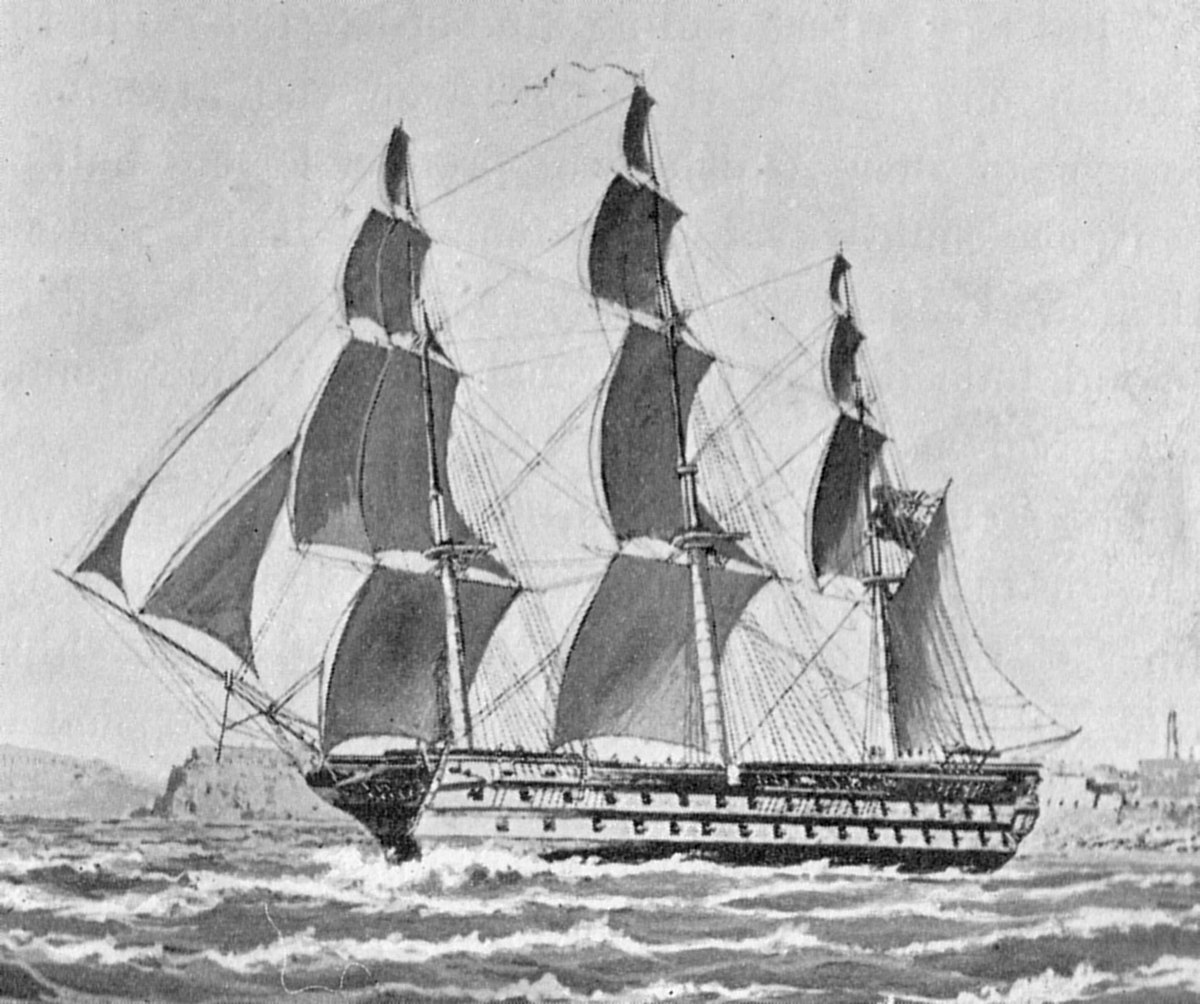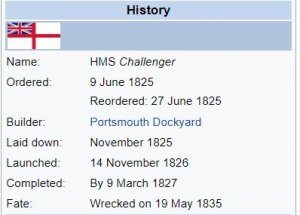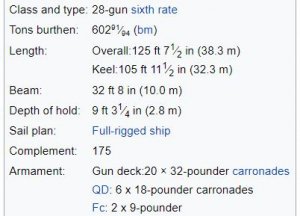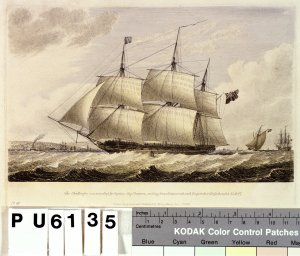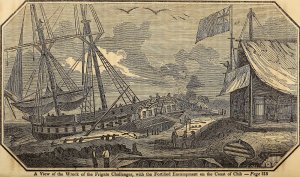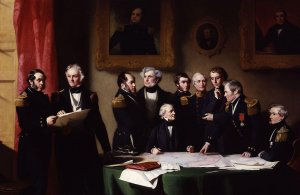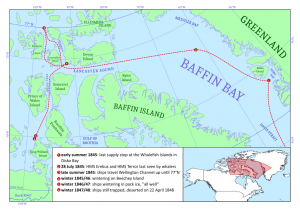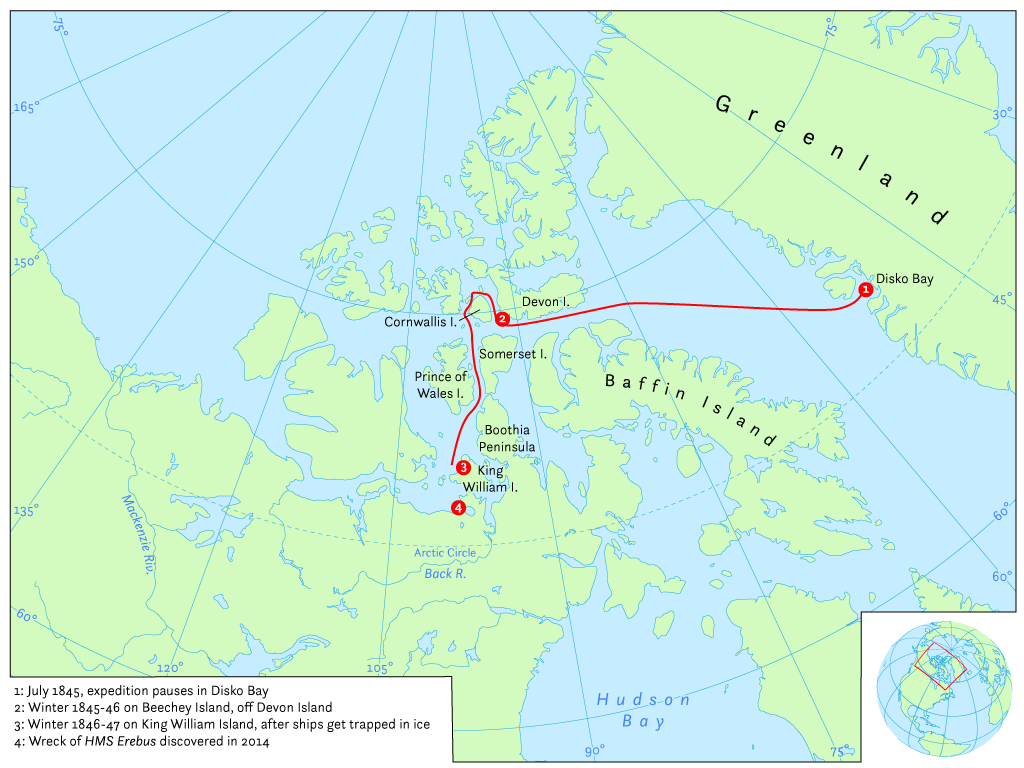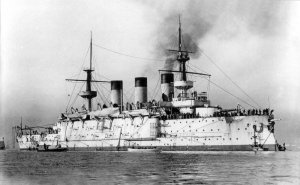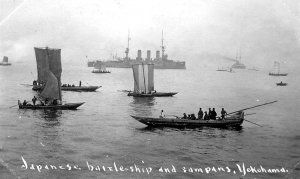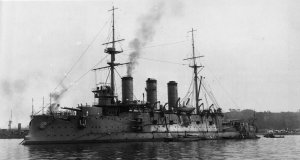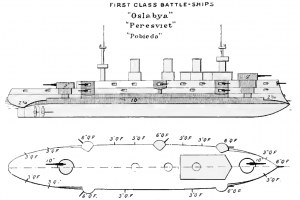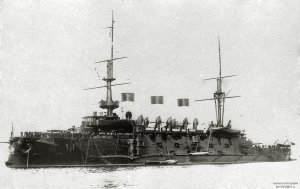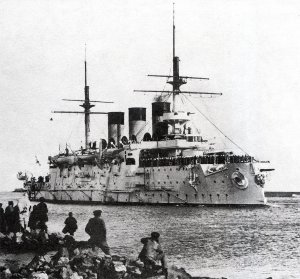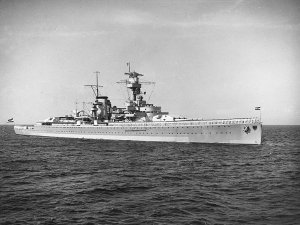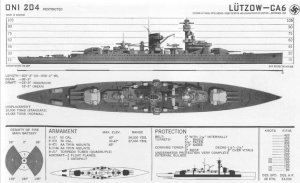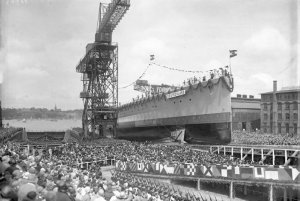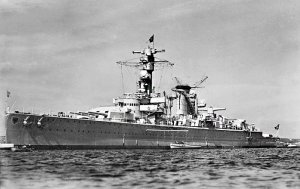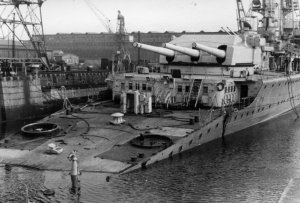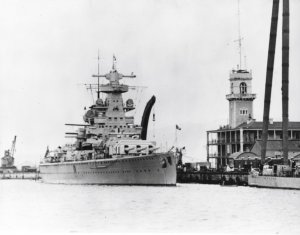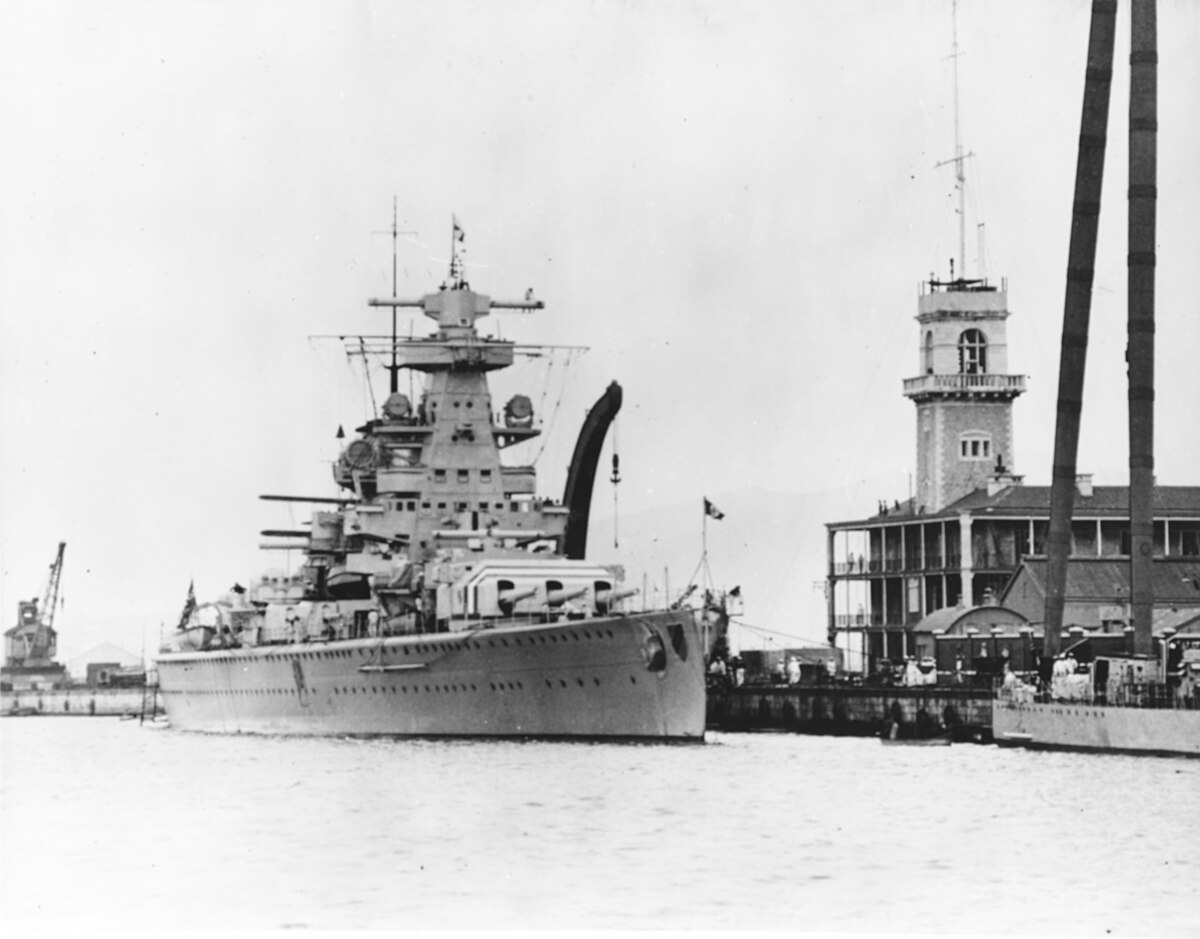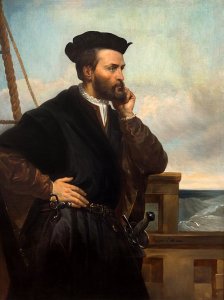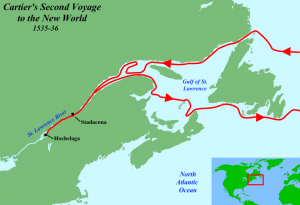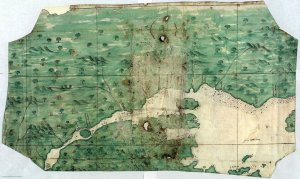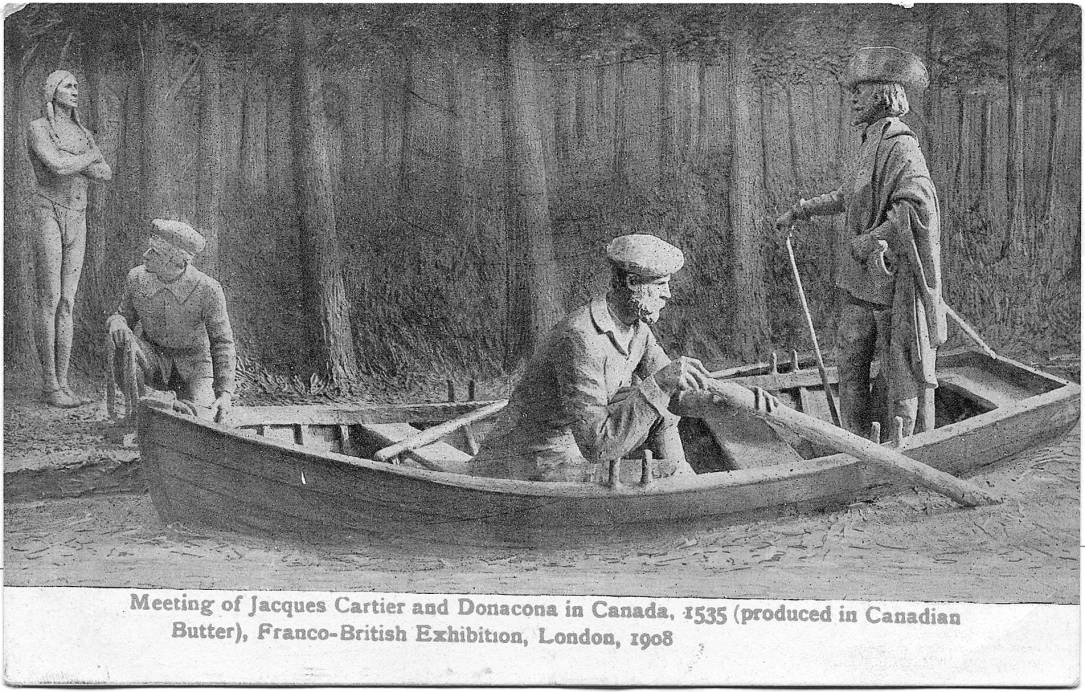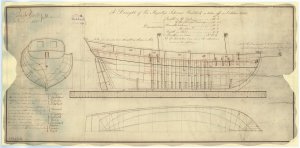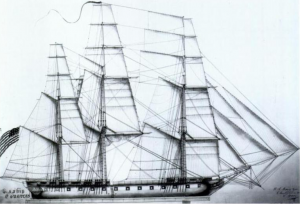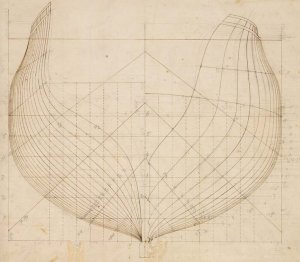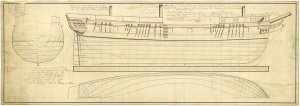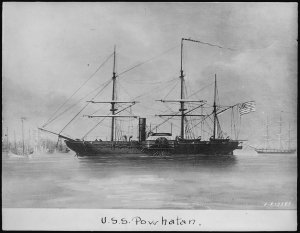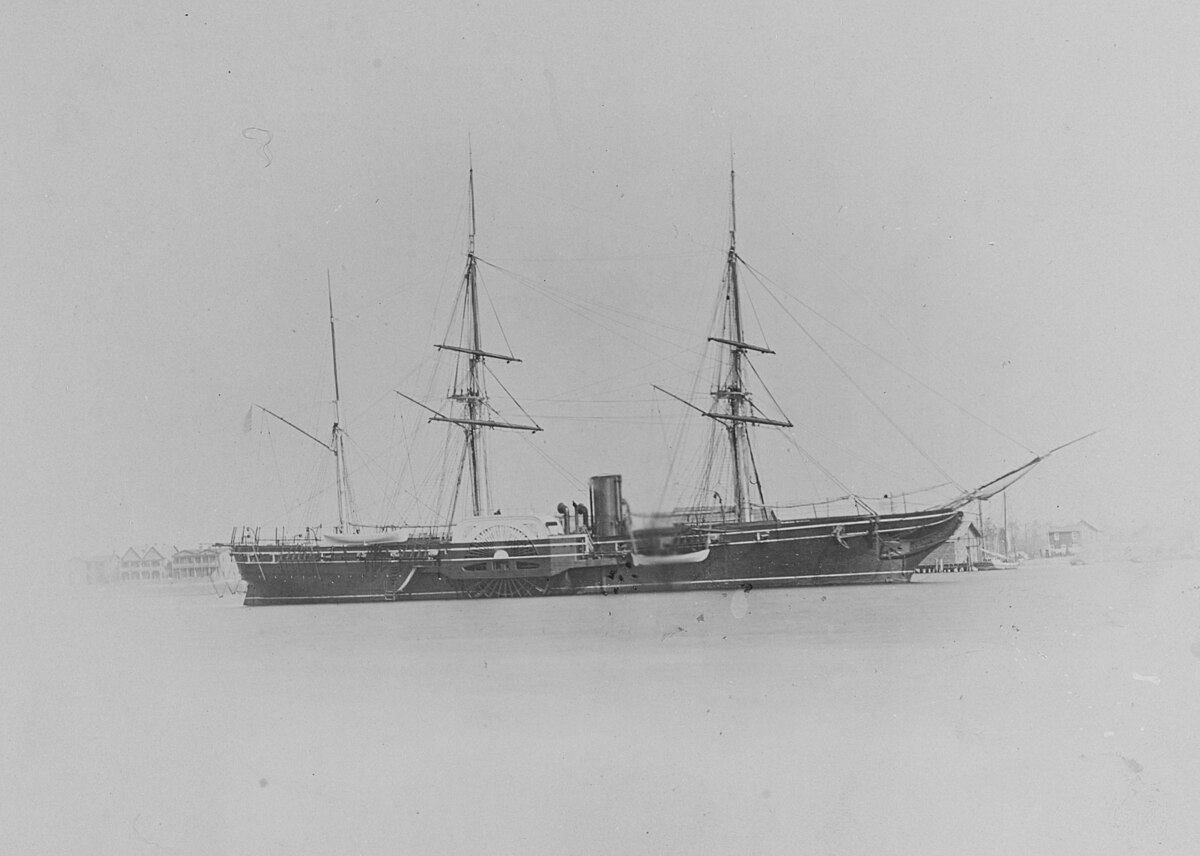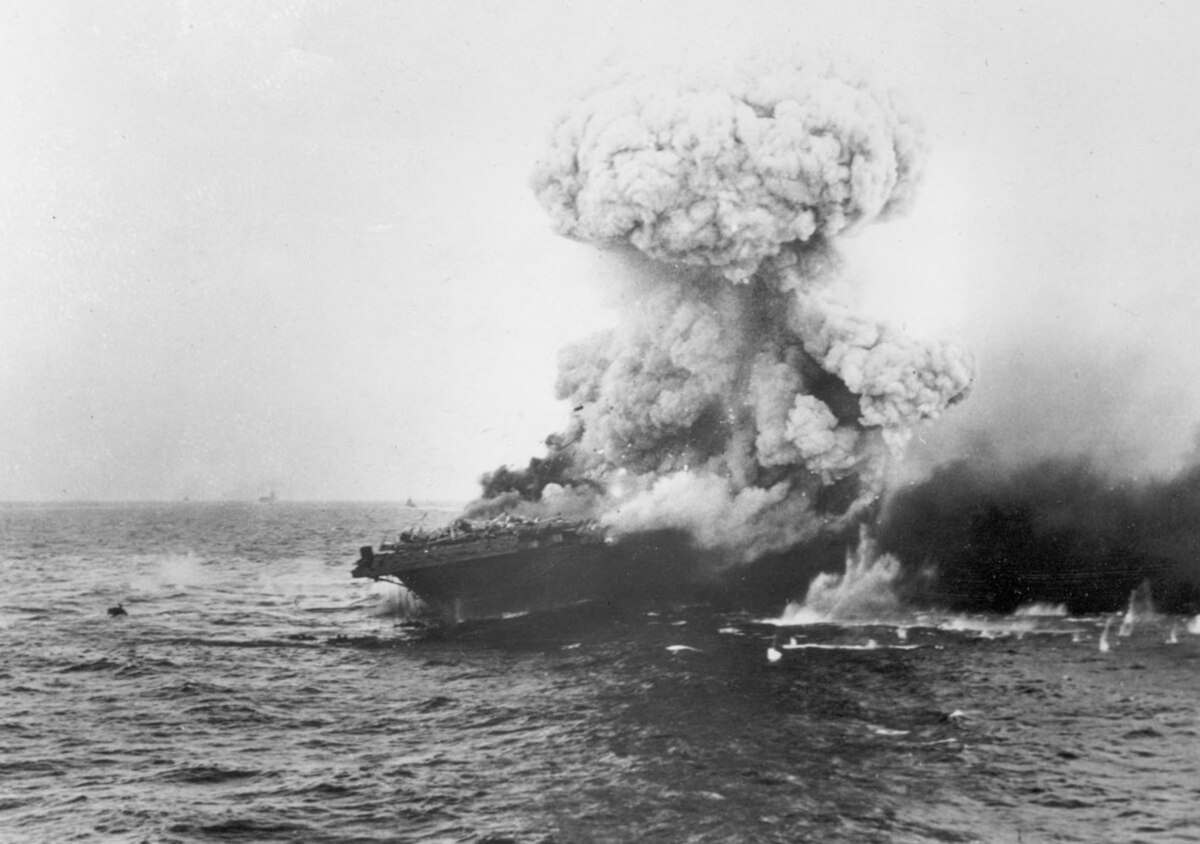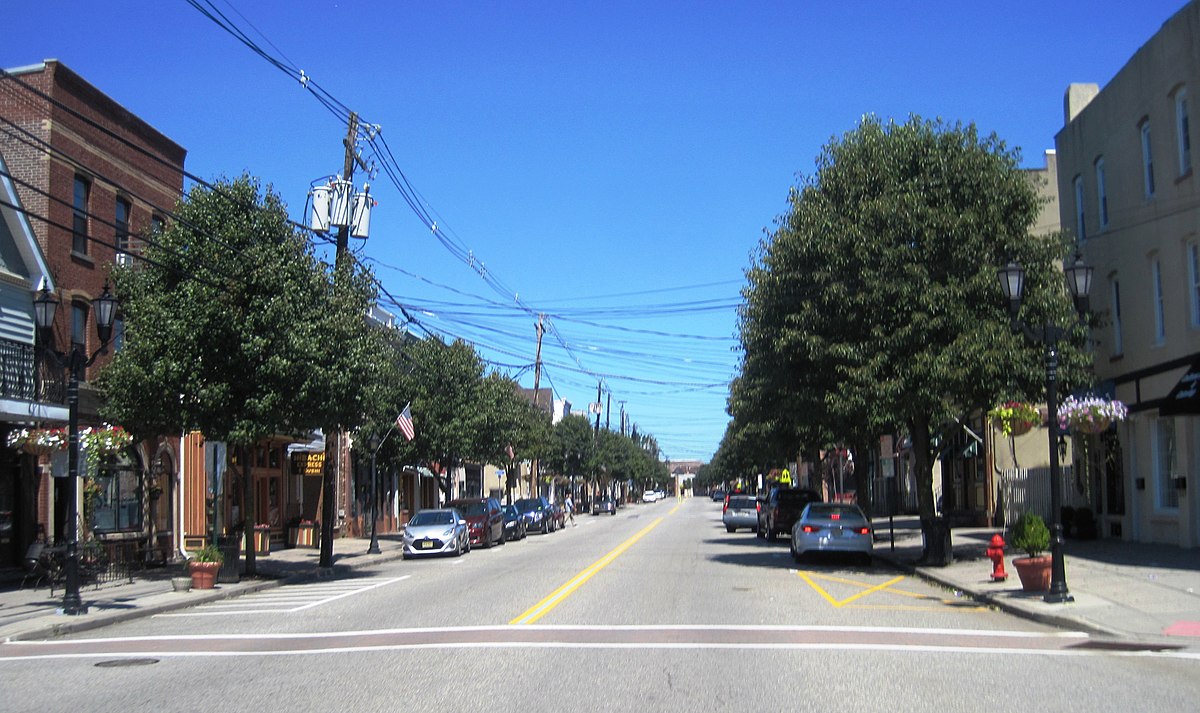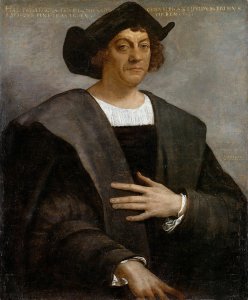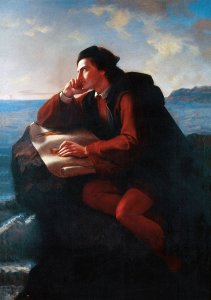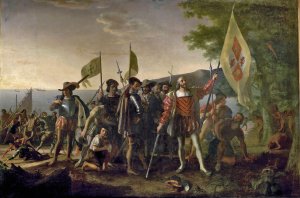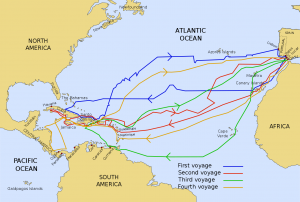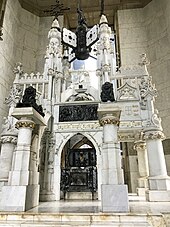Today in Naval History - Naval / Maritime Events in History
19 May 1652 - The naval Battle of Goodwin Sands (also known as the Battle of Dover), fought on 19 May 1652 (29 May 1652 Gregorian calendar), was the first engagement of the First Anglo-Dutch War between the navies of the Commonwealth of England and the United Provinces of the Netherlands.
English fleet under Robert Blake fire on Maarten Tromp's Dutch fleet off Dover starting the First Anglo-Dutch War
The naval Battle of Goodwin Sands (also known as the Battle of Dover), fought on 19 May 1652 (29 May 1652 Gregorian calendar), was the first engagement of the First Anglo-Dutch War between the navies of the Commonwealth of England and the United Provinces of the Netherlands.
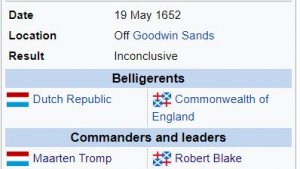

Background
The English Parliament had passed the first of the Navigation Acts in October 1651, aimed at hampering the shipping of the highly trade-dependent Dutch. Agitation among the Dutch merchants had been further increased by George Ayscue's capture in early 1652 of 27 Dutch ships trading with the royalist colony of Barbados in contravention of an embargo. Both sides had begun to prepare for war, but conflict might have been delayed if not for an unfortunate encounter on 29 May 1652 (19 May in the Julian calendar then in use in England) near the Straits of Dover between a Dutch convoy escorted by 40 ships under Lieutenant-Admiral Maarten Tromp and an English fleet of 25 ships under General-at-Sea Robert Blake.
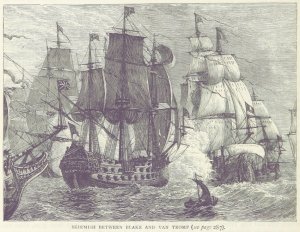
Battle
An ordinance of Cromwell required all foreign fleets in the North Sea or the Channel to dip their flag in salute, but when Tromp did not comply because he saw no reason to lower his flag for the English, Blake fired three warning shots. When the third hit his ship, wounding some sailors, Tromp replied with a warning broadside from his flagship Brederode. Blake then fired a broadside in anger and a five-hour battle ensued.
Aftermath
Both fleets were damaged, but as darkness fell the Dutch fleet withdrew in a defensive line to protect the convoy, and the English captured two Dutch stragglers: Sint Laurens, which was taken back by them but not used, and Sint Maria, which was abandoned in a sinking condition and later made its way to the Netherlands. Tromp then offered his excuses to Blake and asked for the return of the prize, but this was refused by Blake.
War was declared by the Commonwealth on 10 July 1652.
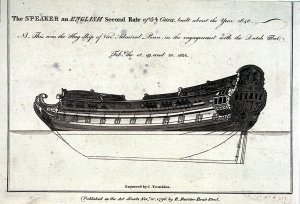
The Speaker an English second rate of 54 Guns built about the year 1640. NB This was the Flag Ship of Vice Admiral Penn in the engagement with the Dutch Fleet Feby the 18, 19 and 20 1652 (PAD0262)
Ships involved
England (Robert Blake)
Totals: Ships: 24
Cannon: 908
Anthony Young's squadron
The Netherlands (Maarten Tromp)
Totals: Ships: 44
Cannon: 1274
Convoyers
Brederode was a ship of the line of the Maas Admiralty, part of the navy of the United Provinces of the Netherlands, and the flagship of the Dutch fleet in the First Anglo-Dutch War. Throughout her career, she carried from 49 to 59 guns. She was named after Johan Wolfert van Brederode, the brother-in-law of stadtholder Frederick Henry, Prince of Orange.
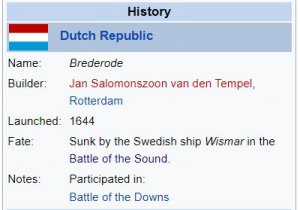
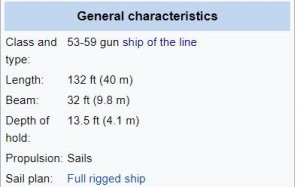
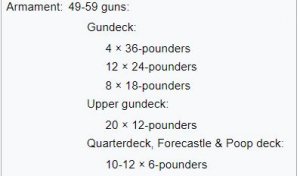
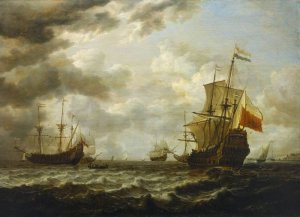
Brederode off Hellevoetsluis by Simon de Vlieger
Construction
Brederode was, in Maas feet, about 132 ft (40 m) long by about 32 ft (9.8 m) wide by approximately 13.5 ft (4.1 m) deep. The English dimensions were very close to those figures. The published dimensions are in Maas feet of 308 mm, divided into 12 inches (300 mm).
Brederode was initially armed with 49 guns, increasing to 54 from 1652. These comprised four 36-pounders, twelve 24-pounders, and eight 18-pounders on the lower deck, twenty 12-pounders on the upper deck, and ten to twelve 6-pounders on the forecastle, quarterdeck, and poop deck. All of her guns were bronze-cast except four of the 12-pounders which were Swedish-made and cast in iron.
Crew numbers varied considerably over Bredereode's sailing career. In September 1652 her complement was 175 sailors, rising to 260 in June 1653 before falling back to 113 in 1656. Between 40 and 75 soldiers were also accommodated aboard.
Ship history
Launched at Rotterdam in 1644, and a design of shipwright Jan Salomonszoon van den Tempel, she was the flagship of Vice-Admiral Witte Corneliszoon de With from May 1645 until 1647 when she was assigned to Lieutenant-Admiral Maarten Tromp. The same year however, she again became De With's flagship for his expedition to Dutch Brazil. De With delegated actual command of the vessel to Lieutenant Jan Janszoon Quack, who remained in that role after the expedition returned to Holland in 1647. Only in 1652 would Tromp sail for the first time with his flag on Brederode, during an attack against royalist privateers operating from the Scilly Islands.
In the First Anglo-Dutch War Brederode was present under Tromp's command at the Battle of Goodwin Sands on 29 May 1652. After Tromp's failure to bring the English to battle off the Shetland Islands in July, Tromp was relieved and Michiel de Ruyter took over command. When De Ruyter was subordinated to De With in September, Brederode's crew refused to let the latter come on board to take command, so he had to content himself with Prins Willem. Without Tromp, Brederode fought at the Battle of the Kentish Knock on 8 October 1652.
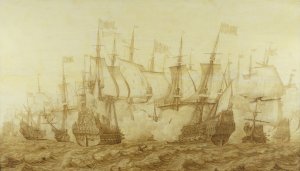
The Battle of the Gabbard, 12 June 1653 by Heerman Witmont, shows the Dutch flagship Brederode (foreground left) in action.
With Tromp back in command, Brederode fought at the Battle of Dungeness on 10 December 1652 where she came close to being captured, but was instrumental in that victory over the English. She fought again on 18 February 1653 at the Battle of Portland and on 12 June 1653 at the Battle of the Gabbard, where she fought an exhausting but inconclusive duel with William Penn's flagship James. On that day, the first day of the battle, Tromp's men boarded the English ship but were beaten back; boarded in turn by the English, Tromp was only able to dislodge the boarders by blowing up Brederode's deck. On 13 June the English were joined by a squadron under Admiral Robert Blake and the Dutch were scattered in defeat.
Brederode fought in the last major engagement of the war, the Battle of Scheveningen on 26 July 1653, when Tromp was killed. The acting flag captain (later Admiral) Egbert Bartholomeusz Kortenaer kept Tromp's standard raised after his death to keep up morale.
In the Northern Wars the United Provinces sent an expeditionary force to support Denmark in the war against Charles X of Sweden. In the Battle of the Sound on 8 November 1658 the Dutch fleet, commanded by Lieutenant-Admiral Jacob van Wassenaer Obdam, defeated a Swedish fleet and relieved the siege of Copenhagen. Van Wassenaer's flagship was Eendracht; De With commanded the van in Brederode; attacking the enemy without proper knowledge of the shoals he grounded his ship (after damaging Leoparden so much that this enemy vessel subsequently was lost by fire) and was surrounded; after many hours of fighting, Brederode was boarded by Wismar and De With mortally wounded. The partially burnt wreck was deemed unsalvagable.
 en.wikipedia.org
en.wikipedia.org

 en.wikipedia.org
en.wikipedia.org
19 May 1652 - The naval Battle of Goodwin Sands (also known as the Battle of Dover), fought on 19 May 1652 (29 May 1652 Gregorian calendar), was the first engagement of the First Anglo-Dutch War between the navies of the Commonwealth of England and the United Provinces of the Netherlands.
English fleet under Robert Blake fire on Maarten Tromp's Dutch fleet off Dover starting the First Anglo-Dutch War
The naval Battle of Goodwin Sands (also known as the Battle of Dover), fought on 19 May 1652 (29 May 1652 Gregorian calendar), was the first engagement of the First Anglo-Dutch War between the navies of the Commonwealth of England and the United Provinces of the Netherlands.


Background
The English Parliament had passed the first of the Navigation Acts in October 1651, aimed at hampering the shipping of the highly trade-dependent Dutch. Agitation among the Dutch merchants had been further increased by George Ayscue's capture in early 1652 of 27 Dutch ships trading with the royalist colony of Barbados in contravention of an embargo. Both sides had begun to prepare for war, but conflict might have been delayed if not for an unfortunate encounter on 29 May 1652 (19 May in the Julian calendar then in use in England) near the Straits of Dover between a Dutch convoy escorted by 40 ships under Lieutenant-Admiral Maarten Tromp and an English fleet of 25 ships under General-at-Sea Robert Blake.

Battle
An ordinance of Cromwell required all foreign fleets in the North Sea or the Channel to dip their flag in salute, but when Tromp did not comply because he saw no reason to lower his flag for the English, Blake fired three warning shots. When the third hit his ship, wounding some sailors, Tromp replied with a warning broadside from his flagship Brederode. Blake then fired a broadside in anger and a five-hour battle ensued.
Aftermath
Both fleets were damaged, but as darkness fell the Dutch fleet withdrew in a defensive line to protect the convoy, and the English captured two Dutch stragglers: Sint Laurens, which was taken back by them but not used, and Sint Maria, which was abandoned in a sinking condition and later made its way to the Netherlands. Tromp then offered his excuses to Blake and asked for the return of the prize, but this was refused by Blake.
War was declared by the Commonwealth on 10 July 1652.

The Speaker an English second rate of 54 Guns built about the year 1640. NB This was the Flag Ship of Vice Admiral Penn in the engagement with the Dutch Fleet Feby the 18, 19 and 20 1652 (PAD0262)
Ships involved
England (Robert Blake)
Totals: Ships: 24
Cannon: 908
Anthony Young's squadron
- President 36 (Anthony Young)
- Nightingale 24 (Jacob Reynolds)
- Recovery 24 (Edmund Chapman)
- James 60 (flag, Robert Blake, captain John Gilson)
- Victory 52 (Lionel Lane)
- Garland 44 (John Gibbs)
- Speaker 52 (John Coppin)
- Ruby 42 (Anthony Houlding)
- Sapphire 38 (Robert Moulton, Jr)
- Worcester 42 (Charles Thorowgood)
- Star 24 (Robert Saunders)
- Portsmouth 36 (William Brandley)
- Martin 12
- Mermaid 24 (Richard Stayner)
- Ruben 26 (merchantman)
- 3 small
- Andrew 56 (Nehemiah Bourne)
- Triumph 62 (William Penn) - Ashore during the battle
- Fairfax 52 (John Lawson)
- Entrance 44
- Centurion 36
- Adventuree 36 (Andrew Ball)
- Assurance 40 (Benjamin Blake)
- Greyhound 20 (Henry Southwood)
- Seven Brothers 26 (hired merchantman, Robert Land)
The Netherlands (Maarten Tromp)
Totals: Ships: 44
Cannon: 1274
Convoyers
- Groningen 38 (Joris van der Zaan)
- Zeelandia 34 (Jacob Huyrluyt)
- Brederode 54 (Maarten Tromp, Admiral, RD)
- Alexander 28 (Jan Maijkers, AD)
- Blauwen Arend 28 (Dirck Pater, AD)
- Sint Salvador 34 (Matheeus Corneliszoon, AD)
- Vliegende Faam 28 (Jacob Corneliszoon Swart, AD)
- Arche Troijane 28 (Abraham van Kampen, AD)
- Kroon Imperiaal 34 (Cornelis Janszoon Poort, AD)
- Valck 28 (Cornelis Janszoon Brouwer, AD)
- Prinses Roijaal 28 (Maarten de Graeff, AD)
- Neptunis 34 (Gerrit van Lummen, AD)
- Sint Matheeus 34 (Cornelis Naeuoogh, AD)
- Prins Maurits 34 (Nicolaes de With, AD)
- Rozeboom 28 (Gerrit Schuyt, AD)
- Engel Gabriel 28 (Bastiaan Bardoel, AD)
- Witte Lam 28 (Cornelis van Houten, AD)
- Gideon van Sardam 34 (Hector Bardesius, AD)
- Sint Francisco 28 (Stoffel Juriaenszoon, AD)
- David en Goliad 34 (Claes Bastiaenszoon Jaarsveld, AD)
- Elias 34 (Jacob Sijvertsen Spanheijm, AD)
- Zwarte Leeuw 28 (Hendrik de Raedt, AD)
- Sint Maria 28 (Sipke Fockes, AD) - Captured but abandoned and recaptured
- Groote Liefde 38 (Bruyn van Seelst, AD)
- Nassouw van den Burgh 34 (Lambert Pieterszoon, AD)
- Groote Vergulde Fortuijn 35 (Frederick de Coninck, AD)
- Engel Michiel 28 (Fredrick Bogaart, AD)
- Vergulde Haan 30 (Jan le Sage, MD)
- Goude Leeuw 30 (Jacob Penssen, MD)
- Leeuwinne 30 (Joannes van Regermorter, MD)
- Sint Laurens 30 (Bastiaan Tuynemans, MD) - Captured
- Witte Lam 32 (Jan Tijssen Matheeus, VD)
- Monnikendam 32 (Pieter Florissen, Rear Admiral, NKA)
- Wapen van Hoorn 24 (Pieter Aldertszoon, NKA)
- Prins Maurits 28 (Cornelis Pieterszoon Taenman, NKA)
- Monnikendam 24 (Arent Dirckszoon, NKA)
- Wapen van Enkhuizen 30 (Gerrit Femssen, NKA)
- Wapen van Alkmaar 28 (Gerrit Nobel, NKA)
- Roode Leeuw 24 (Reynst Corneliszoon Sevenhuysen, NKA)
- Peereboom 24 (Tijs Sijmonszoon Peereboom, NKA)
- Huis van Nassau 28 (Gerrit Munth, NKA)
- Alkmaar 28 (Jan Warnaertszoon Capelman, NKA)
- Sampson 26 (Willem Ham, NKA)
- Stad van Medemblik 26 (Pieter Schellinger, NKA)
- AD - Amsterdam Admiralty and Directors' ships
- MD - Middelburg Admiralty and Directors
- NKA - Noorder-Kwartier Admiralty
- RD - Rotterdam Admiralty
- VD - Vlissingen Directors
Brederode was a ship of the line of the Maas Admiralty, part of the navy of the United Provinces of the Netherlands, and the flagship of the Dutch fleet in the First Anglo-Dutch War. Throughout her career, she carried from 49 to 59 guns. She was named after Johan Wolfert van Brederode, the brother-in-law of stadtholder Frederick Henry, Prince of Orange.




Brederode off Hellevoetsluis by Simon de Vlieger
Construction
Brederode was, in Maas feet, about 132 ft (40 m) long by about 32 ft (9.8 m) wide by approximately 13.5 ft (4.1 m) deep. The English dimensions were very close to those figures. The published dimensions are in Maas feet of 308 mm, divided into 12 inches (300 mm).
Brederode was initially armed with 49 guns, increasing to 54 from 1652. These comprised four 36-pounders, twelve 24-pounders, and eight 18-pounders on the lower deck, twenty 12-pounders on the upper deck, and ten to twelve 6-pounders on the forecastle, quarterdeck, and poop deck. All of her guns were bronze-cast except four of the 12-pounders which were Swedish-made and cast in iron.
Crew numbers varied considerably over Bredereode's sailing career. In September 1652 her complement was 175 sailors, rising to 260 in June 1653 before falling back to 113 in 1656. Between 40 and 75 soldiers were also accommodated aboard.
Ship history
Launched at Rotterdam in 1644, and a design of shipwright Jan Salomonszoon van den Tempel, she was the flagship of Vice-Admiral Witte Corneliszoon de With from May 1645 until 1647 when she was assigned to Lieutenant-Admiral Maarten Tromp. The same year however, she again became De With's flagship for his expedition to Dutch Brazil. De With delegated actual command of the vessel to Lieutenant Jan Janszoon Quack, who remained in that role after the expedition returned to Holland in 1647. Only in 1652 would Tromp sail for the first time with his flag on Brederode, during an attack against royalist privateers operating from the Scilly Islands.
In the First Anglo-Dutch War Brederode was present under Tromp's command at the Battle of Goodwin Sands on 29 May 1652. After Tromp's failure to bring the English to battle off the Shetland Islands in July, Tromp was relieved and Michiel de Ruyter took over command. When De Ruyter was subordinated to De With in September, Brederode's crew refused to let the latter come on board to take command, so he had to content himself with Prins Willem. Without Tromp, Brederode fought at the Battle of the Kentish Knock on 8 October 1652.

The Battle of the Gabbard, 12 June 1653 by Heerman Witmont, shows the Dutch flagship Brederode (foreground left) in action.
With Tromp back in command, Brederode fought at the Battle of Dungeness on 10 December 1652 where she came close to being captured, but was instrumental in that victory over the English. She fought again on 18 February 1653 at the Battle of Portland and on 12 June 1653 at the Battle of the Gabbard, where she fought an exhausting but inconclusive duel with William Penn's flagship James. On that day, the first day of the battle, Tromp's men boarded the English ship but were beaten back; boarded in turn by the English, Tromp was only able to dislodge the boarders by blowing up Brederode's deck. On 13 June the English were joined by a squadron under Admiral Robert Blake and the Dutch were scattered in defeat.
Brederode fought in the last major engagement of the war, the Battle of Scheveningen on 26 July 1653, when Tromp was killed. The acting flag captain (later Admiral) Egbert Bartholomeusz Kortenaer kept Tromp's standard raised after his death to keep up morale.
In the Northern Wars the United Provinces sent an expeditionary force to support Denmark in the war against Charles X of Sweden. In the Battle of the Sound on 8 November 1658 the Dutch fleet, commanded by Lieutenant-Admiral Jacob van Wassenaer Obdam, defeated a Swedish fleet and relieved the siege of Copenhagen. Van Wassenaer's flagship was Eendracht; De With commanded the van in Brederode; attacking the enemy without proper knowledge of the shoals he grounded his ship (after damaging Leoparden so much that this enemy vessel subsequently was lost by fire) and was surrounded; after many hours of fighting, Brederode was boarded by Wismar and De With mortally wounded. The partially burnt wreck was deemed unsalvagable.
Battle of Goodwin Sands - Wikipedia

Dutch ship Brederode (1644) - Wikipedia
Battle of Dover, 19th May 1652
Description and participants : Battle of Dover, 19th May 1652 (1652/05/29 NS)
threedecks.org




